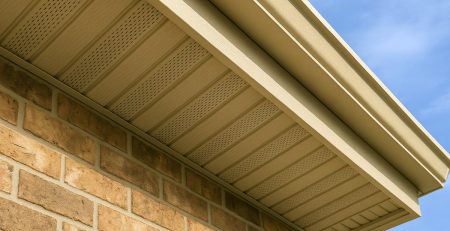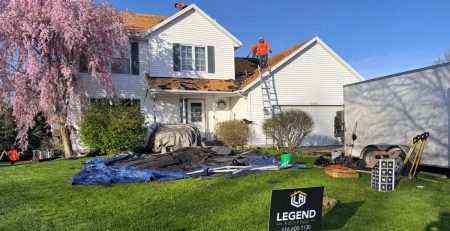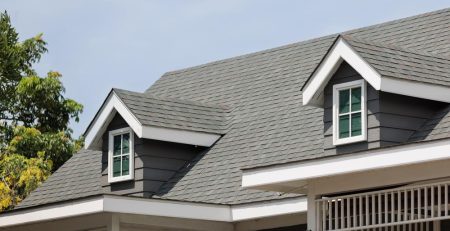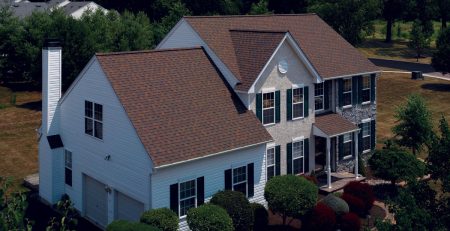How Weather Affects Your Roof in West Michigan
Living in West Michigan means experiencing all four seasons in full force—icy winters, wet springs, hot summers, and blustery autumns. While this makes the region beautiful, it also puts residential roofs through the wringer. The constant fluctuation in temperature, moisture, wind, and UV exposure can wear down even the most durable roofing systems over time. As we head into mid-April, now is the perfect time for homeowners to assess the effects of winter and prepare for the months ahead.
In this blog, we’ll explore how West Michigan weather impacts your roof—and what you can do to protect it year-round.
1. Winter: Snow, Ice, and Freeze-Thaw Cycles
How It Affects Your Roof:
West Michigan winters bring heavy snowfall, ice buildup, and freezing temperatures. Snow accumulation adds extra weight to your roof, while melting snow that refreezes can create ice dams. These ice dams trap water behind them, which can seep under shingles and cause leaks, rot, and insulation damage.
The freeze-thaw cycle—where daytime temperatures rise above freezing and nighttime temps drop below—can also cause roofing materials to expand and contract, weakening seals and creating cracks.
What to Do:
- Clear gutters to ensure melting snow has somewhere to go.
- Inspect attic insulation and ventilation to prevent warm air from melting snow unevenly.
- Use a roof rake to gently remove snow buildup after heavy storms.
- Schedule a post-winter roof inspection in early spring to catch issues before they escalate.
2. Spring: Rain, Wind, and Storm Damage
How It Affects Your Roof:
April in West Michigan can be rainy, windy, and unpredictable. Spring storms bring gusts that can lift or tear off shingles, while driving rain tests the waterproofing integrity of your roof. Saturated soil and clogged gutters may also cause water to back up under your shingles.
What to Do:
- Check your roof after windstorms for missing or lifted shingles.
- Clean gutters and downspouts to direct rainwater safely away from your foundation.
- Inspect flashing and seals around chimneys, skylights, and vents for wear.
- Trim nearby trees to prevent branches from falling onto your roof during storms.
3. Summer: Heat, Sun, and Humidity
How It Affects Your Roof:
While summers in West Michigan aren’t as extreme as in other parts of the country, prolonged sun exposure can still degrade shingles over time. UV rays break down asphalt shingle binders, making them brittle and causing granule loss. Humid conditions can also foster mold, mildew, and algae—particularly in shaded areas.
What to Do:
- Look for bald spots or granule loss on shingles.
- Install algae-resistant shingles or apply protective treatments if necessary.
- Make sure ridge and soffit vents are clear to allow proper airflow.
- Consider light-colored or reflective shingles if your roof tends to overheat.
4. Fall: Leaves, Moisture, and Wind
How It Affects Your Roof:
Autumn’s falling leaves can clog gutters and downspouts, causing water to back up and damage roofing components. This season also brings strong wind gusts from Lake Michigan, especially in coastal communities like Holland, Grand Haven, and Muskegon. Combined with the increased rainfall, your roof can become vulnerable to leaks and rot if not properly maintained.
What to Do:
- Clear gutters and roof valleys regularly.
- Schedule a fall inspection to prepare for winter.
- Remove debris like sticks, leaves, and moss from the roof surface.
- Repair any missing or damaged shingles before the first snowfall.
“Understanding how each season affects your roofing system—and knowing what preventative steps to take—can save you from expensive repairs and extend the life of your investment.”
5. Lake Effect Weather: A Unique Challenge
How It Affects Your Roof:
One of the defining features of West Michigan weather is lake-effect precipitation, especially during the colder months. The proximity to Lake Michigan means snow squalls and abrupt weather changes that can deposit several inches of snow or rain in a short time.
This unpredictability puts added stress on your roofing system. Repeated cycles of sudden wet and dry conditions can accelerate aging in shingles and underlayment.
What to Do:
- Choose high-quality, durable roofing materials rated for harsh climates.
- Install ice and water shields in vulnerable areas like eaves and valleys.
- Work with a local roofing contractor familiar with the specific demands of lake-effect weather.
6. Temperature Swings and Moisture Management
How It Affects Your Roof:
West Michigan is no stranger to dramatic temperature swings, even within the same week. These shifts can cause expansion and contraction in roofing materials, loosening fasteners and weakening structural integrity. Moisture trapped in the attic due to poor ventilation can also condense, leading to mold and mildew growth.
What to Do:
- Install and maintain a balanced ventilation system to reduce moisture buildup.
- Use breathable underlayment that allows moisture to escape.
- Have your roof professionally inspected for signs of warping or movement.
Spring Is Roof Check Season: Here’s Your April Checklist
As the snow melts and temperatures rise, April is an ideal time for homeowners to assess winter wear and prep their roofs for the wet season. Here’s what you can do this month:
April Roof Maintenance Checklist:
- Inspect your roof from the ground using binoculars or a drone.
- Schedule a professional inspection for a full evaluation.
- Clean out gutters and downspouts thoroughly.
- Check for sagging areas, loose shingles, or damaged flashing.
- Ensure attic insulation and ventilation are functioning correctly.
- Look for water stains or mold in the attic space.
- Trim back any branches that hang over your roofline.
FAQ: West Michigan Weather and Your Roof
At least twice a year—ideally in spring and fall. You should also inspect your roof after major storms or temperature shifts.
Yes! Spring is a great time for roof replacements or repairs. Temperatures are moderate, and you can address issues before summer heat or another winter arrives.
Asphalt shingles are the most common choice due to their durability and affordability. Architectural and impact-resistant shingles offer added protection against high winds and hail.
Yes—especially in shaded or humid areas. Choose algae-resistant shingles or have your roof cleaned professionally to prevent buildup.
West Michigan Roofing Contractors
West Michigan weather is beautiful but demanding, especially on your roof. Understanding how each season affects your roofing system—and knowing what preventative steps to take—can save you from expensive repairs and extend the life of your .
Now is the perfect time to take action. If you’re unsure about the current condition of your roof or want help preparing it for the seasons ahead, contact Legend Roofing at (616) 600-1130. We’re local, experienced, and committed to protecting your West Michigan home from whatever Mother Nature throws its way.












